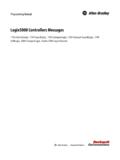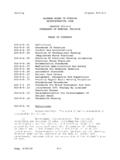Transcription of Chapter 9 Curriculum and Instructional Design
1 Stephen Petrina. (in press). Curriculum and Instruction For Technology Teachers296 Chapter 9 Curriculum and Instructional DesignWho should Design the Curriculum that technology educators teach? Should Curriculum bedeveloped by governments and ministries of education? Should Curriculum Design be privatizedand limited to commercial vendors? Should teachers Design their own Curriculum ? Who shoulddesign the Instructional materials? Should all materials be professionally designed by a vendor?As we noted in the previous Chapter , technology teachers have had a century of freedom indesigning and customizing their Curriculum and instruction to suit themselves, their communityor the students. This had its advantages in diversity. The disadvantages, as we noted, related tothe inconsistencies from school to school, even in the same district.
2 When the teacher departedfrom a school s/he typically departed with the Curriculum and Instructional materials. Newteachers often began their first school year with little more than what they carried with themfrom their teacher preparation programs and student teaching experiences. One major problemwas that when it came time for governments to identify priorities in the schools, technologystudies was overlooked because of its incoherent Curriculum . As indicated in Chapter 8, theinternational trend is quickly shifting toward standards and unified Curriculum in Design andtechnology the trend is toward a consistent scope and sequence of content for the study oftechnology. Common Curriculum and goals along with content and performance standards arethe trends. From a perspective of professional vitality and political finesse, these trends arehealthy.
3 These trends offer the potential for long-term sustainability of technology studies in theschools. Nevertheless, given that all curricula are fallible and have shortcomings, teachers willalways have a need for dispositions toward, or skills and knowledge in, Curriculum andinstructional questions "what should be learned?" and "how should it be organized for teaching?"are eventually resolved, whether by consensus, fiat or might, through processes of curriculumand Instructional Design . One is basically a question of content , the other a question of can be resolved without changing the other the questions are dialectically related. Wecan say that Curriculum and Instructional Design involve the forming of educational content andthe contents of educational forms. Curriculum theorists take it for granted that Curriculum flowsfrom the "what" of "what should be learned?
4 " Instructional designers take it for granted thatinstruction flows from the "how" of "how should it be organized?" Theorists neglect Design . Stephen Petrina. (in press). Curriculum and Instruction For Technology Teachers297 Designers neglect theory. Teachers, however, cannot afford to neglect either theory or Design ;they have to be theorists and designers. In this Chapter , Curriculum and Instructional Design areexplained along with a focus on the Design of projects, units and modules. This chaptercombines background knowledge with techniques of Curriculum and Instructional Design . Insome of the previous chapters, the emphasis was on "what should be learned?" This chapterfocuses on "how should it be organized for teaching?" Curriculum DesignThe practice of organizing Curriculum activities, environments, goals, knowledge, student andteacher interests, social conditions, technologies, values and the like into a containablepedagogical form involves a series of judgments.
5 Judgments are necessarily made on what andwhose knowledge is of most worth, the scope and sequence of this knowledge, how studentdesires will be focused, what technologies to deploy or purchase and so on. Curriculum designslend form to, and chart provisions for, the processes of learning and teaching and becomeconcrete and operational at various stages of educational practice. The very nature of studentexperiences are shaped by the way we choose to Design , or not Design , Curriculum . In otherwords, different Curriculum designs provide varied qualities and powers of experience andknowledge. Curriculum Design might at first glance appear to be about the economics andpragmatics of teaching, about arranging content and assignments, apportioning time ontimetables, and allocating resources. Curriculum is, and is much more than, scope and and profound judgments are made when we plan, shape and judge human between educational outcomes and Curriculum documents is virtuous; but whencurriculum Design is seen as the moral and political endeavor that it is, the issue takes on should be learned?
6 How ought it be organized for teaching? Curriculum designinvolves a form into which Curriculum is cast or organized. Curriculum is generally organizedthrough designs such as: Disciplines ( , mathematics, engineering, humanities, sciences);Fields ( , art, civics, Design , home economics, industrial arts, social studies); Units ( ,bicycling; child labor; feminism, jazz; mass media; queer fiction; verbs; water colors);Organizing Centers ( , activities, modules, minicourses, problems, processes, projects, tasksand competencies); or Personal Pursuits ( , aerobics, autobiography, cooking, bird watching, Stephen Petrina. (in press). Curriculum and Instruction For Technology Teachers298guitar playing). Core or Interdisciplinary designs employ combinations of disciplines or broadfields (Petrina, 1998). Disciplinary, field and interdisciplinary designs typically employ unitsand organizing centers to engage students in pre-structured knowledge.
7 Here, problems andunits are developed to establish understandings of organized bodies of disciplinary designs are generally selected for their powers in bolstering political causes andconferring political status, and since the early 1960s, disciplinary designs have been politicallyvalued over the others. High school humanities and sciences employed disciplinary designs inthe early 1960s to secure economic and liberal roles. Projects and units conferred a progressivestatus in the 1910s and 1920s for newcomers in the school Curriculum such as industrial arts,audio-visual education and social studies. Just as teaching methods are associated with differenttheoretical "families," Curriculum designs have theoretical consensus in Curriculum theory formed around five orientations to organizingcurriculum: academic rationalism, cognitive processes, self-actualization, social reconstruction,and utilitarianism (Eisner and Vallance's, 1974).
8 Academic rationalist orientations are primarilyabout disciplinary knowledge and cultural canons. Cognitive process orientations are primarilyabout intellectual reasoning skills such as problem solving. Self-actualization, or personalrelevance, orientations stress psychological conditions and are concerned with individuality andpersonal expression. Social reconstruction, generally called critical pedagogy, stressessociological conditions, social justice and collective reform. Utilitarian orientations areprimarily concerned with functional competencies, performance, procedure and instructionalefficiency. Curriculum designs are conceptually grounded in any one or a mix of theseorientations. In 1992, a special issue of the Journal of Technology Education was published toexplore each of these five designs (see Herschbach and Sanders, 1992).
9 A basic conclusion fromthis is that generic, neutral theoretical orientations and designs for organizing Curriculum simplydo not exist (Beyer and Apple, 1988; Eisner, 1979; Zuga, 1989).Nevertheless, theorists of these five designs play into the hands of educators and policymakers who for centuries ranked Curriculum by political value: liberal arts and universitypreparation Curriculum are valued over practical or technical Curriculum . Four theoreticalorientations, generally ranked in the order previously introduced, hold not only historical status,but also theoretical status over the instrumental or utilitarian Curriculum . Furthermore, theoristsconflated utilitarian orientations with technology, making things more confusing. As a result, Stephen Petrina. (in press). Curriculum and Instruction For Technology Teachers299any school Curriculum that takes "practical" work as its subject has a low theoretical status and,as it has nearly always been, a questionable historical status.
10 Today, business, home economicsand technology in the Curriculum connote instrumental, transmissive and technical , business educators, home economists and technology educators may have designedinstrumental Curriculum , but this was never any more instrumental or utilitarian than the arts,humanities, maths or sciences for theorists conclude that there are three basic orientations to Curriculum transmissive, transactive and transformative Curriculum or technical, practical and emancipatorycurriculum. If we can hold off on ranking these, there is great value in theorizing transmissive,transactive and transformative orientations to Curriculum . In fact, teachers can be quiteempowered by the knowledge and skills in designing Curriculum that is at times transmissive,and other times transactive or transformative.



